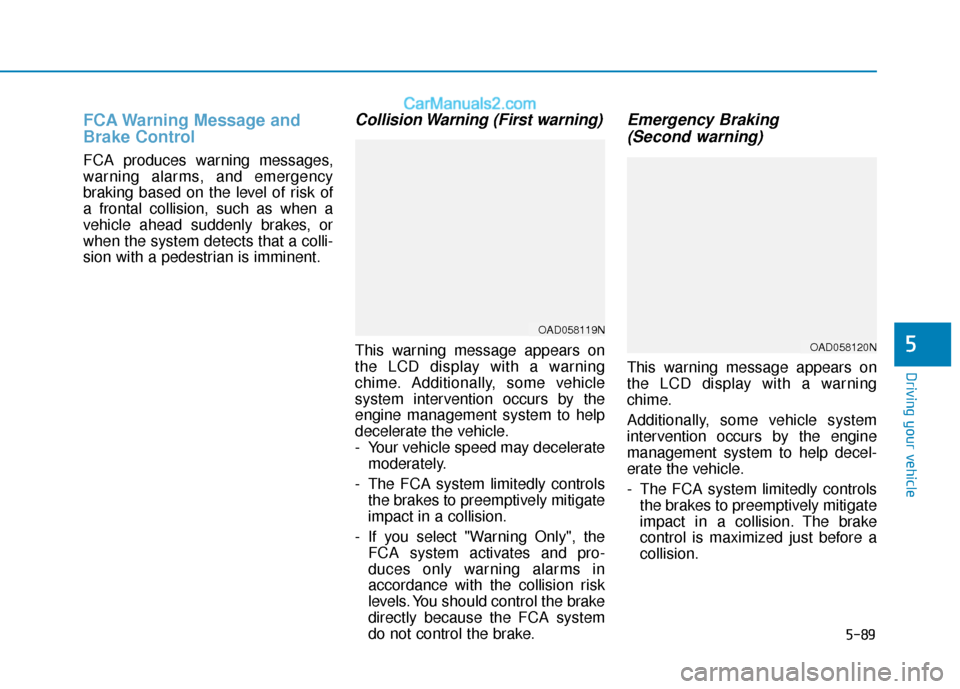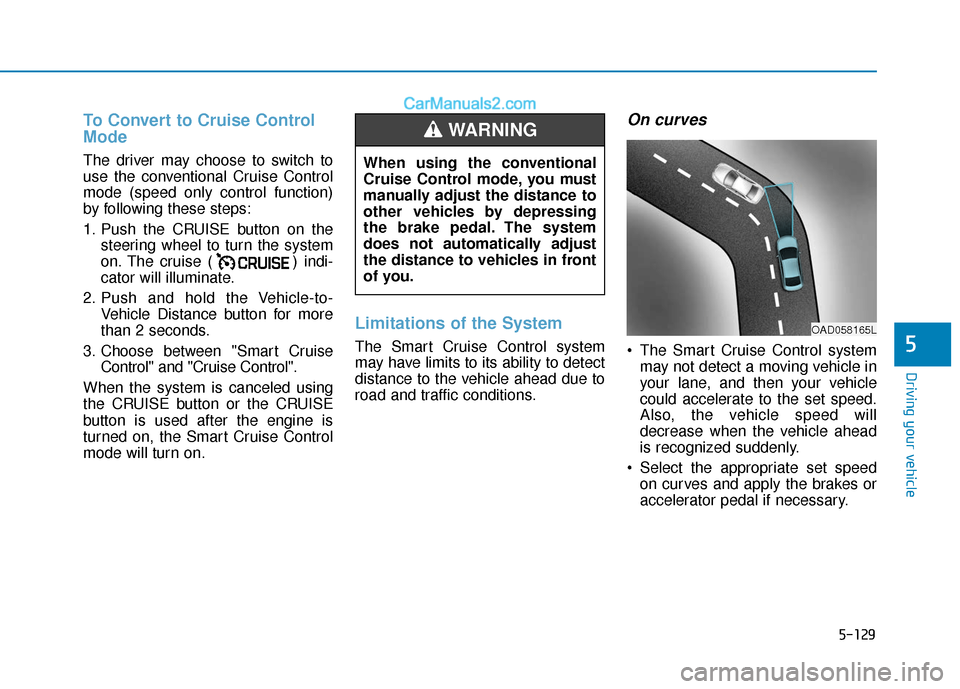2020 Hyundai Elantra ECO mode
[x] Cancel search: ECO modePage 325 of 535

5-89
Driving your vehicle
5
FCA Warning Message and
Brake Control
FCA produces warning messages,
warning alarms, and emergency
braking based on the level of risk of
a frontal collision, such as when a
vehicle ahead suddenly brakes, or
when the system detects that a colli-
sion with a pedestrian is imminent.
Collision Warning (First warning)
This warning message appears on
the LCD display with a warning
chime. Additionally, some vehicle
system intervention occurs by the
engine management system to help
decelerate the vehicle.
- Your vehicle speed may deceleratemoderately.
- The FCA system limitedly controls the brakes to preemptively mitigate
impact in a collision.
- If you select "Warning Only", the FCA system activates and pro-
duces only warning alarms in
accordance with the collision risk
levels. You should control the brake
directly because the FCA system
do not control the brake.
Emergency Braking(Second warning)
This warning message appears on
the LCD display with a warning
chime.
Additionally, some vehicle system
intervention occurs by the engine
management system to help decel-
erate the vehicle.
- The FCA system limitedly controls
the brakes to preemptively mitigate
impact in a collision. The brake
control is maximized just before a
collision.
OAD058119N
OAD058120N
Page 363 of 535

5-127
Driving your vehicle
5
Warning message
Smart Cruise Control disabled.
Radar blocked
When the sensor lens cover is
blocked with dirt, snow, or debris, the
Smart Cruise Control system opera-
tion may stop temporarily. If this
occurs, a warning message will
appear on the cluster LCD display.
Remove any dirt, snow, or debris and
clean the radar sensor lens cover
before operating the Smart Cruise
Control system. The Smart Cruise
Control system may not properly
activate, if the radar is totally con-
taminated, or if any substance is not
detected after turning on the engine
(e.g. in an open terrain).
Information
For the SCC operation is temporarily
stopped if the radar is blocked, but
you wish to use conventional cruise
control mode (speed only control func-
tion), you must convert to the cruise
control mode (refer to "To convert to
Cruise Control mode" in the following
page).
i
Do not apply license plate
frame or foreign objects such
as a bumper sticker or a
bumper guard near the radar
sensor. Doing so may
adversely affect the sensing
performance of the radar.
Always keep the radar sensor
and lens cover clean and free
of dirt and debris.
Use only a soft cloth to wash
the vehicle. Do not spray pres-
surized water directly on the
sensor or sensor cover.
CAUTION
Be careful not to apply unnec-
essary force on the radar sen-
sor or sensor cover. If the sen-
sor is forcibly moved out of
proper alignment, the Smart
Cruise Control system may
not operate correctly. In this
case, a warning message may
not be displayed. Have the
vehicle inspected by an
authorized HYUNDAI dealer.
If the front bumper becomes
damaged in the area around
the radar sensor, the Smart
Cruise Control System may
not operate properly. Have the
vehicle inspected by an
authorized HYUNDAI dealer.
Use only genuine HYUNDAI
parts to repair or replace a
damaged sensor or sensor
cover. Do not apply paint to
the sensor cover.
OIK057108L
Page 365 of 535

5-129
Driving your vehicle
5
To Convert to Cruise Control
Mode
The driver may choose to switch to
use the conventional Cruise Control
mode (speed only control function)
by following these steps:
1. Push the CRUISE button on thesteering wheel to turn the system
on. The cruise ( ) indi-
cator will illuminate.
2. Push and hold the Vehicle-to- Vehicle Distance button for more
than 2 seconds.
3. Choose between "Smart Cruise Control" and "Cruise Control".
When the system is canceled using
the CRUISE button or the CRUISE
button is used after the engine is
turned on, the Smart Cruise Control
mode will turn on.
Limitations of the System
The Smart Cruise Control system
may have limits to its ability to detect
distance to the vehicle ahead due to
road and traffic conditions.
On curves
The Smart Cruise Control system may not detect a moving vehicle in
your lane, and then your vehicle
could accelerate to the set speed.
Also, the vehicle speed will
decrease when the vehicle ahead
is recognized suddenly.
Select the appropriate set speed on curves and apply the brakes or
accelerator pedal if necessary.
When using the conventional
Cruise Control mode, you must
manually adjust the distance to
other vehicles by depressing
the brake pedal. The system
does not automatically adjust
the distance to vehicles in front
of you.
WARNING
OAD058165L
Page 473 of 535

7-51
7
Maintenance
All Season Tires
HYUNDAI specifies all season tires
on some models to provide good
performance for use all year round,
including snowy and icy road condi-
tions. All season tires are identified
by ALL SEASON and/or M+S (Mud
and Snow) on the tire sidewall. Snow
tires have better snow traction than
all season tires and may be more
appropriate in some areas.
Summer Tires
HYUNDAI specifies summer tires on
some models to provide superior
performance on dry roads. Summer
tire performance is substantially
reduced in snow and ice. Summer
tires do not have the tire traction rat-
ing M+S (Mud and Snow) on the tire
side wall. If you plan to operate your
vehicle in snowy or icy conditions,
HYUNDAI recommends the use of
snow tires or all season tires on all
four wheels.
Snow Tires
If you equip your car with snow tires,
they should be the same size and
have the same load capacity as the
original tires. Snow tires should be
installed on all four wheels; other-
wise, poor handling may result. Snow
tires should carry 4 psi (28 kPa)
more air pressure than the pressure
recommended for the standard tires
on the tire label on the driver’s side of
the center pillar, or up to the maxi-
mum pressure shown on the tire
sidewall, whichever is less. Do not
drive faster than 75 mph (120 km/h)
when your vehicle is equipped with
snow tires.
Radial-Ply Tires
Radial-ply tires provide improved
tread life, road hazard resistance and
smoother high speed ride. The radi-
al-ply tires used on this vehicle are of
belted construction, and are selected
to complement the ride and handling
characteristics of your vehicle.Radial-ply tires have the same load
carrying capacity, as bias-ply or bias
belted tires of the same size, and use
the same recommended inflation
pressure. Mixing of radial-ply tires
with bias-ply or bias belted tires is
not recommended. Any combina-
tions of radial-ply and bias-ply or bias
belted tires when used on the same
vehicle will seriously deteriorate
vehicle handling. The best rule to fol-
low is: Identical pairs of radial-ply
tires should always be used as a set
for the front tires and a set for the
rear tires.
Longer wearing tires can be more
susceptible to irregular tread wear. It
is very important to follow the tire
rotation interval in this chapter to
achieve the tread life potential of
these tires. Cuts and punctures in
radial-ply tires are repairable only in
the tread area, because of sidewall
flexing. Consult your tire dealer for
radial-ply tire repairs.
Page 527 of 535

I-5
Door locks .......................................................................3\
-12Auto door lock/unlock features ..................................3-15
Central door lock switch ............................................3-14
Child-protector rear door locks ..................................3-16
Door lock button ........................................................3-13
Mechanical key ..........................................................3-12
Remote key.................................................................3-12
Safe Exit Assist (SEA) system ...................................3-16
Smart key....................................................................3-13\
Drinks holders, see cup holders ....................................3-142
Drive mode integrated control system ............................5-51
Driver assist system Rear view monitor ....................................................3-112
Driver Attention Warning (DAW) system ....................5-109
Driver position memory system .....................................3-18
Driver's air bag................................................................2-45
Driver's knee airbag ........................................................2-45
Driving at night .............................................................5-135
Driving in flooded areas ...............................................5-136
Driving in the rain.........................................................5-135
Dual clutch transmission.................................................5-26 Good driving practices ...............................................5-37
Manual shift mode......................................................5-35
Shift lock system ........................................................5-36
Shift-lock release ........................................................5-36
Transmission temperature and warning message.......5-28 Electric chromic mirror (ECM) with HomeLink
®system,
compass and Blue Link®.............................................3-24
Electric Power Steering (EPS) ........................................3-21
Electronic stability control (ESC)...................................5-44
Emergency towing ..........................................................6-38
Emission control system .................................................7-83 Crankcase emission control system ...........................7-83
Evaporative emission control System includinding onboard refueling vapor recovery (ORVR) ............7-83
Exhaust emission control system ...............................7-84
Engine compartment..................................................1-6, 7-3
Engine compartment panel fuse replacement .................7-57
Engine coolant ................................................................7-23
Engine coolant temperature gauge .................................3-56
Engine number ................................................................8-11
Engine oil ........................................................................\
7-21
Engine specification..........................................................8-2
Engine start/stop button ....................................................5-9
Evaporative emission control System includinding onboard refueling vapor recovery (ORVR) .................7-83
Exhaust emission control system....................................7-84
Explanation of scheduled maintenance items.................7-18
Exterior care....................................................................7-75\
Exterior lights .................................................................3-99
I
Index
E
Page 534 of 535

I-12
Tachometer ......................................................................3-\
56
Theft alarm system .........................................................3-17
Tilt steering/Telescopic steering .....................................3-21
Tire chains .....................................................................5-1\
37
Tire loading information label ......................................5-142
Tire Mobility Kit .............................................................6-22
Tire pressure monitoring system (TPMS) ........................6-9Changing a tire with TPMS .......................................6-13
Low tire pressure LCD display with position indicator...................................................................6-11
Low tire pressure telltale ............................................6-11
TPMS malfunction indicator ......................................6-12
Tire rotation ....................................................................7-41\
Tire specification and pressure label ..............................8-11
Tires and wheels .............................................................7-38 All season tires ...........................................................7-51
Checking tire inflation pressure .................................7-40
Compact spare tire replacement .................................7-43
Low aspect ratio tires .................................................7-52
Radial-ply tires ...........................................................7-51
Recommended cold tire inflation pressures ...............7-39
Snow tires ...................................................................5-51
Summer tires ..............................................................7-51
Tire care ......................................................................7-\
38
Tire maintenance ........................................................7-44
Tire replacement .........................................................7-42 Tire rotation ................................................................7-41
Tire sidewall labeling .................................................7-44
Tire terminology and definitions ................................7-48
Tire traction ................................................................7-43
Wheel alignment and tire balance ..............................7-42
Wheel replacement .....................................................7-43
Tires and wheels ...............................................................8-5
Towing ........................................................................\
....6-36
Trailer towing................................................................5-146
Transmission shift indicator............................................3-60
Transmission temperature and warning message ...........5-28
Trip computer Conventional cluster...................................................3-91
Supervision cluster .....................................................3-95
Trunk ........................................................................\
.......3-44 Emergency trunk safety release .................................3-45
Smart trunk .................................................................3-46
Trunk room lamp ..........................................................3-107
Turn signals...................................................................3-104\
USB charger ..................................................................3-147
User settings mode..........................................................3-83
Index
T
U